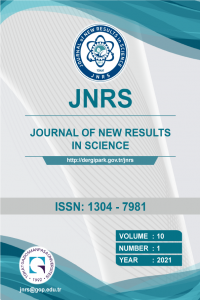Comparison of different helichrysum species in terms of agro-morphological characteristics and essential oil content
Comparison of different helichrysum species in terms of agro-morphological characteristics and essential oil content
Helichrysum stoechas, Helichrysum italicum Immortelle, Goldengrass,
___
- T. Baytop, Turkish plant name dictionary (second press), Turkish Language Association Publications, Ankara, 1997.
- H. Eroğlu, E. Hamzaoğlu, A. Aksoy, Ü. Budak, S. Albayrak, Cytogenetic effects of Helichrysum arenarium in human lymphocytes cultures, Turkish Journal of Biology, 34(3), (2010) 253–259.
- D. A. Muravjova, I. A. Sam’lina, G. P. Yakovlev, Farmakognozija, Meditsina, Moscow, 2002.
- I., Kutluk, M. Aslan, I. E. Orhan, B. Özçelik, Antibacterial, antifungal and antiviral bioactivities of selected Helichrysum species, South African Journal of Botany, 119, (2018) 252–257.
- M. M. Staver, I. Gobin, I. Ratkaj, M. Petrovic, A. Vulinovic, M. Dinarina-Sablic, D. Broznic, In vitro antiproliferative and antimicrobial activity of the essential oil from the flowers and leaves of Helichrysum italicum (Roth) G. Don growing in Central Dalmatia (Croatia), Journal of Essential Oil Bearing Plants, 21(1), (2018) 77–91.
- M. Carini, G. Aldini, S. Furlanetto, R. Stefani, R. M. Facino, LC coupled to ion-trap MS for the rapid screening and detection of polyphenol antioxidants from Helichrysum, Journal of Pharmaceutical and Biomedical Analysis, 24(3), (2001) 517–526.
- M. Idaomar, R. El-Hamss, F. Bakkali, N. Mezzoug, A, Zhiri, D. Baudoux, A. Munoz-Serrano, V. Liemans, A. Alonso-Moraga, Genotoxicity and antigenotoxicity of some essential oils evaluated by wing spot test of Drosophila melanogaster, Mutation Research, 513(1–2), (2002) 61–68.
- G. R. Schinella, H. A. Tournier, J. M. Prieto, P. Mordujovich de Buschiazzo, J. L. Rios, Antioxidant activity of anti-inflamatuary plant extracts, Life Sciences, 70(9), (2002) 1023–1033.
- A. Sala, M. Recio, R. M. Giner, S. Máñez, H. Tournier, G. Schinella, J. L Ríos, Anti-inflamatuary and antioxidant properties of Helichrysum, Journal of Pharmaceutical Pharmacology, 54(3), (2002) 365–371.
- N. M. Pınar, E. Oybak-Dönmez, Pollen morphology of some Turkish endemic Helichrysum Mill. species (Compositae), Pakistan Journal of Botany, 32(2), (2000) 295–301.
- B. Öztürk, Comparison of the flavonoids and essential oil contents of Turkish Helichrysum's and their antioksidant, antimicrobial activity potantials, PhD Dissertation, Ege University (2004) İzmir, Türkiye (in Turkish).
- J. Mastelic, O. Politeo, I. Jerkovic, N. Radosevic, Composition and antimicrobial activity of Helichrysum italicum essential oil and its terpene and terpenoid fractions, Chemistry of Natural Compounds, 41(1), (2005) 35–40.
- V. Roussis, M. Tsoukatou, I. B. Chinou, C. Harvala, Composition and antibacterial activity of the essential oils of two Helichrysum stoechas varieties growing in the Island of Crete, Journal of Essential Oil Research, 14(6), (2002) 459–461.
- I. Telci, E. Bayram, G. Yılmaz, B. Avcı, Variability in essential oil composition of Turkish basils (Ocimum basilicum L.), Biochemical Systematics and Ecology, 34(6), (2006) 489–497.
- Z. Miloradovic, D. Glamoclija, V. Popovic, L. Jovanovic, S. Popovic, V. Ugrenovic, V. Filipovic, Fresh yield biomass immortelle and essential oils contents depending on the growing locality, in: N. Aleksić, A. Mancone (Eds.), International Eco-Conference 2018, Novi Sad, Serbia, 2018, pp. 241–251.
- ISSN: 1304-7981
- Yayın Aralığı: 3
- Başlangıç: 2012
- Yayıncı: TOKAT GAZİOSMANPAŞA ÜNİVERSİTESİ
Finite coproducts in the category of quadratic modules of Lie algebras
Emre ÖZEL, Ummahan EGE ARSLAN, İbrahim İlker AKÇA
Determination of the functional properties of some Nigerian and imported rice varieties
Ikoko OMENAOGOR, Ike OLUKA, Paul Chukwuka EZE
Rough statistical convergence of double sequences in intuitionistic fuzzy normed spaces
On double summability methods $\left| \mathcal{A}_{f}\right| _{k}$ and $\left| C,0,0\right|_{s}$
Determination of the physicomechanical characteristics of black chickpea grains
Hamide ERSOY, Ebubekir ALTUNTAŞ
On the Richard and Raoul numbers
Different computational approach for Fourier transforms by using variational iteration method
A web scraping-based approach for fundamental analysis platform in financial assets
